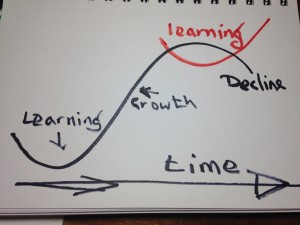In March 2015 Charles Handy [an important thinker in business and management] published “The Second Curve: Thoughts on Reinventing Society”. Two things struck me about the book; 1] that I’ve been fortunate to be able to start working on the “Second Curve” several times, and 2] a reference to a particular event in his undergraduate days at Oxford, which resonates with my current circumstance.
His idea of the second curve is that so much of the stuff of life has an “S” shaped curve if you try and graph it out against time, the top tilted a lot to the right. There’s some sort of investment in the early stages and you slip down the curve a bit but as time moves on things get better and you rise up the curve until you get to the top. After a bit more time the decline sets in. This is the “first curve” and he gives many areas of life where this “S” curves can be seen from learning a job, to successful business to social change. The “Second Curve” is where you [and we as a society] should be looking for something to move onto/into before the first curve starts its decline.
I have the impression that many men, when they reach retirement haven’t invested in the “Second Curve” whatever that curve may be for them. They stop work and then what? “Is he getting under your feet?” someone asked Jill when I stopped working full-time “certainly not! “ is her riposte. I’ve not stopped completely being a physiotherapist but I have moved to locum work, and I have done a lot of thinking about how I am going to fill the hours which, ‘till now, were filled by working [and the traveling to and from work].
I thought my time was going to be a mix of woodcarving, assisting in the garden and on the allotment [I am a dab hand at making compost] with modest travelling in our campervan and a few big holidays [New York again, for example]. Well, over the last year it’s all moved on. I found the carving needed clay modelling too and I developed the feeling that I needed some sort of tutor. I wouldn’t be satisfied without some external input.
In October of last year I signed up part-time on York College’s BA in Contemporary 3D Crafts. One part of the course needs me to produce a blog – so here it is. I suppose it should, over time, be filled with my thoughts on the journey to being a craftsperson – my 10,000 hours of gaining skills and developing ideas. Which brings me to point 2] mentioned above from Charles Handy’s book.
In Chapter 13, The Schools of the Future”, [on page 178 of my copy] he says, with reference to the last half of his degree course at Oxford,
“On one occasion, hard pressed for time, I copied out a passage from a distinguished historian. When I reached that point, reading my essay out aloud as we were required to do, my tutor said nothing, but walked over to his bookcase, took down the works of said historian, rummaged through the pages until he reached the crucial point, then just went on reading aloud the sentences following my bit. Nothing more was said. I got the point. He was interested in my thoughts, not those of other experts”.
And I find myself, for the first time in a similar position. I do not recall in any of my earlier educational experiences being asked what I thought. Even my vague recollections of english lit. at school was spouting out what had been said by others in the texts to accompany the set works. Now, I create stuff and have to justify why I have done what I have done – And that includes recognising why I have done certain things and why I have stopped at a particular point.
Part of that justification of what I do has to refer to what I know of the work of others [naming them and their influences where I can] and “placing” my work in the context of what has gone before; That sounds a bit like the novelty of inventions [a future blog piece?]. It does seem a bit odd after all the years of science and referencing the work of others to abandon that approach. But that is what is going to happen: There will no Harvard referencing in this blog. But I will be developing my “Second” Curve [or is it the 7th curve, 1] patent office to european attorneys, 2] married to single, 3] move to physiotherapy, 4] evolving into married again, 5] NHS to private practice, 6] walk away from private practice, 7] start BA ??].
More later,
Vincent






